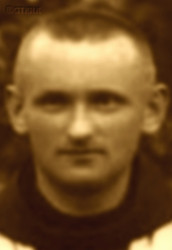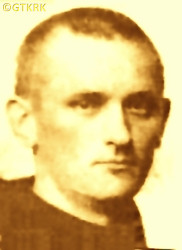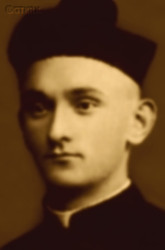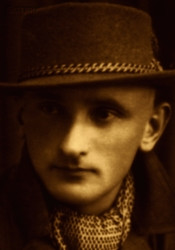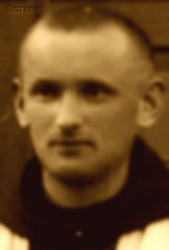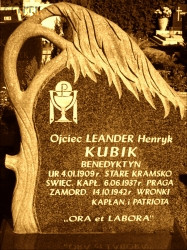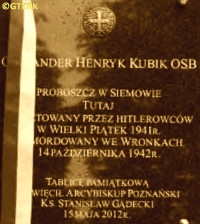Roman Catholic
St Sigismund parish
05-507 Słomczyn
85 Wiślana Str.
Konstancin deanery
Warsaw archdiocese, Poland
full list:
displayClick to display full list

searchClick to search full list by categories
wyświetlKliknij by wyświetlić pełną listę po polsku

szukajKliknij by przeszukać listę wg kategorii po polsku

Martyrology of the clergy — Poland
XX century (1914 – 1989)
personal data
surname
KUBIK
forename(s)
Henry (pl. Henryk)
religious forename(s)
Leander
function
religious cleric
creed
Latin (Roman Catholic) Church RCmore on
en.wikipedia.org
[access: 2014.09.21]
congregation
Order of Saint Benedict OSBmore on
en.wikipedia.org
[access: 2013.05.19]
(i.e. Benedictines, Black Monks)
diocese / province
Gniezno and Poznań archdiocese (aeque principaliter)more on
www.archpoznan.pl
[access: 2012.11.23]
RC Military Ordinariate of Polandmore on
en.wikipedia.org
[access: 2014.12.20]
date and place
of death
14.10.1942

Wronkitoday: Wronki gm., Szamotuły pov., Greater Poland voiv., Poland
more on
en.wikipedia.org
[access: 2021.06.20]
details of death
After German and Russian invasion of Poland in 09.1939 and start of the World War II, after start of German occupation, interned by the Germans in his monastery in Lubiń, where the Germans organized a transit camp for Polish priests serving in the occupied areas of Wielkopolska, transformed by the Germans into a new province Germ. Warthegau (Eng. Warta Country).
However, allowed to act as administrator of the nearby Siemowo parish, abandoned by its parish priest, Fr Edmund Stankiewicz, who had been in danger of an imminent arrest.
In 1940 became chaplain of „Black Legion”, Polish Clandestine resistance organisation active in Gostyń in Greater Poland region, part of Polish Clandestine State.
In 04.1941 the organization was infiltrated and smashed by the Germans.
Arrested by the Germans on 11.04.1941, on Good Friday, in his parish church where was praying.
Jailed in Gostyń and next in Rawicz prison.
Maltreated and tortured.
On 27.10.1941 transported to Zwickau heavy prison.
Treated as German citizen and in 04.1942 sentenced in Zwickau to 5 years of hard labor (12 members of „Black Legion” were sentenced to death on guillotine, dozens to prison terms ‐ 38 of them perished in jails).
Jailed in Darmstadt, Eich and finally in Wronki.
There tortured and murdered by the Germans.
cause of death
extermination: exhaustion
perpetrators
Germans
sites and events
WronkiClick to display the description, KL Zwickau / Schloß OstersteinClick to display the description, RawiczClick to display the description, Reichsgau WarthelandClick to display the description, Ribbentrop‐MolotovClick to display the description, Pius XI's encyclicalsClick to display the description
date and place
of birth
04.01.1909Birth certification on:
photos.szukajwarchiwach.gov.pl
[access: 2025.04.13]

Stare Kramskotoday: Babimost gm., Zielona Góra pov., Lubusz voiv., Poland
more on
en.wikipedia.org
[access: 2021.12.18]
parents
KUBIK Charles
🞲 ?, ? — 🕆 ?, ?

WICZAK Marianne
🞲 ?, ? — 🕆 ?, ?
religious vows
01.01.1933 (temporary)
presbyter (holy orders)
ordination
06.06.1937

Praguetoday: Prague miasto reg., Czechia
more on
en.wikipedia.org
[access: 2020.07.31]
positions held
1940 – 1941
administrator — Siemowotoday: Gostyń gm., Gostyń pov., Greater Poland voiv., Poland
more on
en.wikipedia.org
[access: 2022.12.05] ⋄ Exaltation of the Holy Cross and St Mary Magdalene RC parish ⋄ Gostyńtoday: Gostyń gm., Gostyń pov., Greater Poland voiv., Poland
more on
en.wikipedia.org
[access: 2021.07.18] RC deanery
1937 – 1941
monk — Lubińtoday: Krzywiń gm., Kościan pov., Greater Poland voiv., Poland
more on
en.wikipedia.org
[access: 2021.07.18] ⋄ Abbey, Benedictines OSB
till 1937
student — Beurontoday: Sigmaringen dist., Tübingen reg., Baden‐Württemberg state, Germany
more on
en.wikipedia.org
[access: 2022.04.12] ⋄ philosophy and theology, St Martin Archabbey, Benedictines OSB
from 1933
student — Praguetoday: Prague miasto reg., Czechia
more on
en.wikipedia.org
[access: 2020.07.31] ⋄ philosophy and theology, monastery („Emmaus”), Benedictines OSB
1931 – 01.01.1933
novitiate — Lubińtoday: Krzywiń gm., Kościan pov., Greater Poland voiv., Poland
more on
en.wikipedia.org
[access: 2021.07.18] ⋄ Abbey, Benedictines OSB — also: postulate
1931
accession — Benedictines OSB
1930 – 1931
student — Lutsktoday: Lutsk city rai., Volyn obl., Ukraine
more on
en.wikipedia.org
[access: 2021.09.17] ⋄ philosophy and theology, Theological Seminary
1929 – 1930
pupil — Volodymyr‐Volynskyitoday: Volodymyr, Volodymyr urban hrom., Volodymyr rai., Volyn obl., Ukraine
more on
en.wikipedia.org
[access: 2020.07.31] ⋄ Minor Theological Seminary (Seminarium Minus) — last class at the gymnasium level, completed with the matura exam
others related
in death
STANKIEWICZClick to display biography Edmund
sites and events
descriptions
Wronki: Penal prison in 1939‐1945 managed by the Germans — called Strafgefüngnis Wronki — for the prisoners sentenced to 6 months to 2 years incarceration, mainly Poles. Altogether up to 28,000 inmates were held there. After 1945 it was a jail for political prisoners, „enemies” of Russian‐Polish Commie‐Nazis. (more on: www.sw.gov.plClick to attempt to display webpage
[access: 2013.08.17], pl.wikipedia.orgClick to attempt to display webpage
[access: 2013.08.17])
KL Zwickau / Schloß Osterstein: A heavy German prison in Zwickau in Saxony, founded in 1770‐1775 at the Schloß Osterstein castle. In the XIX c., among its detainees were Karl May, August Bebel, Rosa Luxemburg. During World War II, prob. had the status of Germ. Konzentrationslager (Eng. concentration camp) KL Zwickau / Schloß Osterstein and political prisoners were held there under an extralegal system, euphemistically known as the German Schutzhaft (Eng. protective custody). Prisoners, living in overcrowded cells, slave laboured in the city receiving starvation rations. (more on: en.wikipedia.orgClick to attempt to display webpage
[access: 2010.08.11])
Rawicz: Prison, founded in 1819‐1821, in place of the Franciscan Friars Minor's monastery, which was liquidated by the Prussian occupation authorities. During the World War II, during the German occupation of 1939‐1945, the German Germ. Zuchthaus (Eng. heavy prison), intended for men sentenced to long‐term imprisonment and penal camp sentences, levied mainly by the Germ. Warthegau (Eng. Wartha region) occupation courts. A large part of the prisoners were next transported from there to German concentration camps. After the end of the military operations of World War II, the prison was managed by the Commie‐Nazi authorities of the Russian prl republic. Many activists of the Polish clandestine independence underground were detained there, including soldiers of the Home Army AK. Political prisoners were finally released in 1956. (more on: pl.wikipedia.orgClick to attempt to display webpage
[access: 2013.08.17])
Reichsgau Wartheland: After the Polish defeat in the 09.1939 campaign, which was the result of the Ribbentrop‐Molotov Pact and constituted the first stage of World War II, and the beginning of German occupation in part of Poland (in the other, eastern part of Poland, the Russian occupation began), the Germans divided the occupied Polish territory into five main regions (and a few smaller). The largest one was transformed into Germ. Generalgouvernement (Eng. General Governorate), intended exclusively for Poles and Jews and constituting part of the so‐called Germ. Großdeutschland (Eng. Greater Germany). Two were added to existing German provinces. From two other separate new provinces were created. Greater Poland region was one of them, incorporated into Germany on 08.10.1939, by decree of the German leader Adolf Hitler (formally came into force on 26.10.1939), and on 24.01.1940 transformed into the Germ. Reichsgau Wartheland province, in which the law of the German state was to apply. The main axis of the policy of the new province, the territory of which the Germans recognized as the Germ. „Ursprünglich Deutsche” (Eng. „natively German”), despite the fact that 90% of its inhabitants were Poles, was Germ. „Entpolonisierung” (Eng. „Depolonisation”), i.e. forced Germanization. C. 100,000 Poles were murdered as part of the Germ. „Intelligenzaktion”, i.e. extermination of Polish intelligentsia and ruling classes. C. 630,000 were forcibly resettled to the Germ. Generalgouvernement, and their place taken by the Germans brought from other areas occupied by Germany (e.g. the Baltic countries, Bessarabia, Bukovina, etc.). Poles were forced to sign the German nationality list, the Germ. Deutsche Volksliste DVL. As part of the policy of „Ohne Gott, ohne Religion, ohne Priesters und Sakramenten” (Eng. „No God, no religion, no priest or sacrament”) most Catholic priests were arrested and sent to concentration camps. All schools teaching in Polish, Polish libraries, theaters and museums were closed. Polish landed estates confiscated. To further reduce the number of the Polish population, Poles were sent to forced labor deep inside Germany, and the legal age of marriage for Poles was increased (25 for women, 28 for men). The German state office, Germ. Rasse‐ und Siedlungshauptamt (Eng. Main Office of Race and Settlement) RuSHA, under the majesty of German law, abducted several thousand children who met specific racial criteria from Polish families and subjected them to forced Germanization, handing them over to German families. After the end of hostilities of World War II, the overseer of this province, the Germ. Reichsstatthalter (Eng. Reich Governor) and the Germ. Gauleiter (Eng. district head) of the German National Socialist Party, Arthur Karl Greiser, was executed. (more on: en.wikipedia.orgClick to attempt to display webpage
[access: 2024.06.21])
Ribbentrop‐Molotov: Genocidal Russian‐German alliance pact between Russian leader Joseph Stalin and German leader Adolf Hitler signed on 23.08.1939 in Moscow by respective foreign ministers, Mr. Vyacheslav Molotov for Russia and Joachim von Ribbentrop for Germany. The pact sanctioned and was the direct cause of joint Russian and German invasion of Poland and the outbreak of the World War II in 09.1939. In a political sense, the pact was an attempt to restore the status quo ante before 1914, with one exception, namely the „commercial” exchange of the so‐called „Kingdom of Poland”, which in 1914 was part of the Russian Empire, fore Eastern Galicia (today's western Ukraine), in 1914 belonging to the Austro‐Hungarian Empire. Galicia, including Lviv, was to be taken over by the Russians, the „Kingdom of Poland” — under the name of the General Governorate — Germany. The resultant „war was one of the greatest calamities and dramas of humanity in history, for two atheistic and anti‐Christian ideologies — national and international socialism — rejected God and His fifth Decalogue commandment: Thou shall not kill!” (Abp Stanislav Gądecki, 01.09.2019). The decisions taken — backed up by the betrayal of the formal allies of Poland, France and Germany, which on 12.09.1939, at a joint conference in Abbeville, decided not to provide aid to attacked Poland and not to take military action against Germany (a clear breach of treaty obligations with Poland) — were on 28.09.1939 slightly altered and made more precise when a treaty on „German‐Russian boundaries and friendship” was agreed by the same murderous signatories. One of its findings was establishment of spheres of influence in Central and Eastern Europe and in consequence IV partition of Poland. In one of its secret annexes agreed, that: „the Signatories will not tolerate on its respective territories any Polish propaganda that affects the territory of the other Side. On their respective territories they will suppress all such propaganda and inform each other of the measures taken to accomplish it”. The agreements resulted in a series of meeting between two genocidal organization representing both sides — German Gestapo and Russian NKVD when coordination of efforts to exterminate Polish intelligentsia and Polish leading classes (in Germany called «Intelligenzaktion», in Russia took the form of Katyń massacres) where discussed. Resulted in deaths of hundreds of thousands of Polish intelligentsia, including thousands of priests presented here, and tens of millions of ordinary people,. The results of this Russian‐German pact lasted till 1989 and are still in evidence even today. (more on: en.wikipedia.orgClick to attempt to display webpage
[access: 2015.09.30])
Pius XI's encyclicals: Facing the creation of two totalitarian systems in Europe, which seemed to compete with each other, though there were more similarities than contradictions between them, Pope Pius XI issued in 03.1937 (within 5 days) two encyclicals. In the „Mit brennender Sorge” (Eng. „With Burning Concern”) published on 14.03.1938, condemned the national socialism prevailing in Germany. The Pope wrote: „Whoever, following the old Germanic‐pre‐Christian beliefs, puts various impersonal fate in the place of a personal God, denies the wisdom of God and Providence […], whoever exalts earthly values: race or nation, or state, or state system, representatives of state power or other fundamental values of human society, […] and makes them the highest standard of all values, including religious ones, and idolizes them, this one […] is far from true faith in God and from a worldview corresponding to such faith”. On 19.03.1937, published „Divini Redemptoris” (Eng. „Divine Redeemer”), in which criticized Russian communism, dialectical materialism and the class struggle theory. The Pope wrote: „Communism deprives man of freedom, and therefore the spiritual basis of all life norms. It deprives the human person of all his dignity and any moral support with which he could resist the onslaught of blind passions […] This is the new gospel that Bolshevik and godless communism preaches as a message of salvation and redemption of humanity”… Pius XI demanded that the established human law be subjected to the natural law of God , recommended the implementation of the ideal of a Christian state and society, and called on Catholics to resist. Two years later, National Socialist Germany and Communist Russia came together and started World War II. (more on: www.vatican.vaClick to attempt to display webpage
[access: 2023.05.28], www.vatican.vaClick to attempt to display webpage
[access: 2023.05.28])
sources
personal:
www.benedyktyni.plClick to attempt to display webpage
[access: 2012.11.23], www.benedyktyni.plClick to attempt to display webpage
[access: 2012.11.23], www.parafiasiemowo.plClick to attempt to display webpage
[access: 2015.09.30], photos.szukajwarchiwach.gov.plClick to attempt to display webpage
[access: 2025.04.13]
original images:
www.parafiasiemowo.plClick to attempt to display webpage
[access: 2015.09.30], lbc.leszno.plClick to attempt to display webpage
[access: 2022.08.09], www.parafiasiemowo.plClick to attempt to display webpage
[access: 2015.09.30], www.babimojszczyzna.plClick to attempt to display webpage
[access: 2015.09.30], www.babimojszczyzna.plClick to attempt to display webpage
[access: 2015.09.30], kramsko.pl.tlClick to attempt to display webpage
[access: 2015.09.30], www.parafia.siemowo.plClick to attempt to display webpage
[access: 2019.10.13]
LETTER to CUSTODIAN/ADMINISTRATOR
If you have an Email client on your communicator/computer — such as Mozilla Thunderbird, Windows Mail or Microsoft Outlook, described at WikipediaPatrz:
en.wikipedia.org, among others — try the link below, please:
LETTER to CUSTODIAN/ADMINISTRATORClick and try to call your own Email client
If however you do not run such a client or the above link is not active please send an email to the Custodian/Administrator using your account — in your customary email/correspondence engine — at the following address:

giving the following as the subject:
MARTYROLOGY: KUBIK Henry
To return to the biography press below:
 Click to return to biography
Click to return to biography








